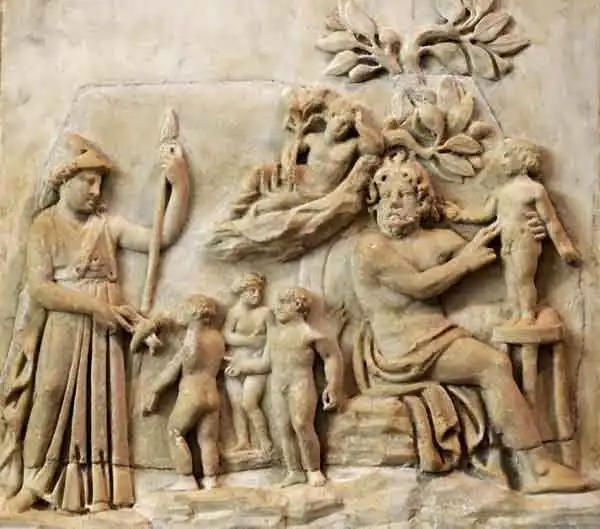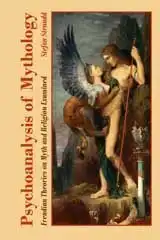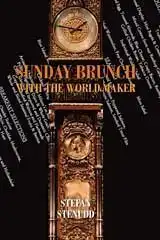Creation Myths
|
by Stefan Stenudd |
I return again to the triangle of functions: those of explanation, norm, and art. None of them equals religion, although the norm corner shares many traits with it. But this similarity is one of function, and not one of substance. In other words, religion partly resembles creation myths because it shares some of its functions. But they remain separate entities, even in cultures where they are closely linked or even intermingled.
Religion is not the most relevant perspective in order to understand creation myths. It can be used on cultures where a religious apparatus is likely to have transformed the creation myth for its purposes, in order to discover what alterations of the myth this has led to, thereby to extract them and find a version closer to what might have been its original form. But the emergence of creation myths has other incentives.
If creation myths are to be analyzed by tools developed within history of religion, the above needs to be remembered. Still, this discipline is well equipped to find and interpret the ingredients of norms and morality in the myths.

Prometheus creates man. Italian marble relief from the 3rd century CE.
An approach that is at least as relevant is that of the history of science. Much is learned about creation myths when they are seen as early forms of cosmology, anthropology, biology, psychology, and so on. This is the explanatory corner of the triangle of functions, so there is no conflict with the material when using this kind of approach – as long as it is not used exclusively.
The history of science is able to bring light to several aspects of a creation myth, but not all of them. Although the explanatory ambition was much more instrumental in the emergence of creation myths than any religious intention, this perspective alone can be just as misleading.
Art history, the history of literature in particular, is a third possible perspective by which to examine creation myths. They are stories, often evidently poetic, and in many cultures they are among the oldest examples of what we call literature. Also, they follow the patterns and forms of narrations and drama that we see in the history of literature. Dramaturgy is easily applied to them.
The oldest myths are also rich with the characteristics of stories handed down by oral transmission. Even though it's likely that creation myths were regarded as plausible representations of the world’s beginning, when they were invented, their forms were molded into what agrees with any traditional work of fiction, and they can be read as such.
The myths that were widely spread and kept in people’s minds, remaining for centuries and even millennia, succeeded in this primarily because of their attraction as stories, whether believable or not.
When Aristotle in his Poetics claimed that a drama is better off being impossible but probable than possible but improbable, he referred to the inner logics of the story. By its premises, plot and events, a story can make what is otherwise impossible seem probable. But when the plot turns into something improbable, it doesn't help if it's quite possible in the outside world.
So, the believability of a creation myth obeys the laws of fiction more than those of science or faith.
From the above follows that proper study of creation myths should be done in more than one perspective, where none of them is allowed to set the agenda. Only if all three corners of the triangle of functions are considered, preferably through the means of their separate academic disciplines, there is a chance of reaching an adequate understanding of the myth.
What Can Be Reached
When a creation myth is examined at depth, with methods such as those presented above, there is a great chance of revealing quite a lot about the myth as well as its source. For example, it can add significantly to our knowledge of the culture where it emerged and what the minds of its population were able, as well as what they sought for and aspired to accomplish. What made them tick, as we would express it.The myth itself can be cleaned from later influences and alterations, so that it is reconstructed into the proximity of its original form. Then it can be used as a key to how its inventors and upholders perceived the world. This also gives substantial clues as to how they lived their lives and what beliefs and dreams they fostered.
A reconstructed myth demonstrates the ability of its inventor’s mind. What deductive ability this mind had will be just as evident as its sense of beauty – its power of reason and of imagination.
The more creation myths are examined at the same depth, considering all their complexity, the more will be revealed about the patterns of human thought and the workings of the human mind. Creation myths are examples of human creativity when it excels. So, comparing them will show just what is the height of human mental ability – in very distant times, but also to some extent what is latent in the mind of present man, perhaps not used in the same way, or maybe not at all, but nonetheless a possibility.
I dare say that we have to go very far back in time to find a mind radically different from ours. What we learn about Homo rudis, his forefathers and his offspring, will tell us much about ourselves, otherwise hidden behind countless veils of knowledge and other kinds of camouflage.
The patterns of thought that the creation myths can expose, when investigated properly, are not that different from those of our own minds. Therefore Homo rudis can teach us a lot about ourselves, if we stop assuming that his mind was vastly inferior just because he did not have as many resources at his disposal as we do.
Start
- Introduction
- Man, Too
- Human Thought Revealed
- Trusting Creation Myths
- Time and Place
- Authenticity
- Inner Story Logics
- Function
- Triangle of Functions
- The Relief of Tragedy
- Homo Rudis
- Present Day Tribes
- Belief
- Doubt
- The Evolution of Creation Myths
- Subconscious Creation
- Simplicity and Urgency
- The All Was Born in the Past
- Originality
- Religion, Science, or Art
- What Can Be Reached
This text was written as an introduction of sorts to my ongoing dissertation on creation myths, at the Lund University History of Ideas and Learning.
Some of My Books:Click the image to see the book at Amazon (paid link).
The Greek philosophers and what they thought about cosmology, myth, and the gods. |
MENU
Creation Myths Around the World
How stories of the beginning began.
The Meanings of Mythology
Theories through history about myth and fable.
Archetypes in Myths
The mythological symbols and what they stand for.
The Logics of Myth
Patterns of creation.
CREATION MYTHS IN DEPTH
Creation in Rig Veda 10:129
The paradox of origin, according to an Indian myth.
Genesis 1
The first creation story of the bible scrutinized.
Enuma Elish
The ancient Babylonian creation myth.
Xingu Creation of Man
The insoluble solitude of gods and humans.
Contact
About Cookies
ON MY OTHER WEBSITES
Psychoanalysis of Myth
What Sigmund Freud and C. G. Jung thought about myths, their origins and meanings.
Myth of Creation
An introduction to the subject of creation myths and the patterns of thought they reveal.
Cosmos of the Ancients
What the Greek philosophers believed about the cosmos, their religion and their gods.
Life Energy
The many ancient and modern life force beliefs all over the world explained and compared.
Taoistic
Taoism, the ancient Chinese philosophy of life explained. Also, the complete classic text Tao Te Ching online.
 Stefan Stenudd
Stefan Stenudd
About me
I'm a Swedish author and historian of ideas, researching the thought patterns in creation myths. I've also written books about Taoism, the Tarot, and life force concepts around the world. Click the image to get to my personal website.

 Archetypes of Mythology
Archetypes of Mythology Psychoanalysis of Mythology
Psychoanalysis of Mythology Cosmos of the Ancients
Cosmos of the Ancients Life Energy Encyclopedia
Life Energy Encyclopedia Sunday Brunch with the World Maker
Sunday Brunch with the World Maker Fake Lao Tzu Quotes
Fake Lao Tzu Quotes